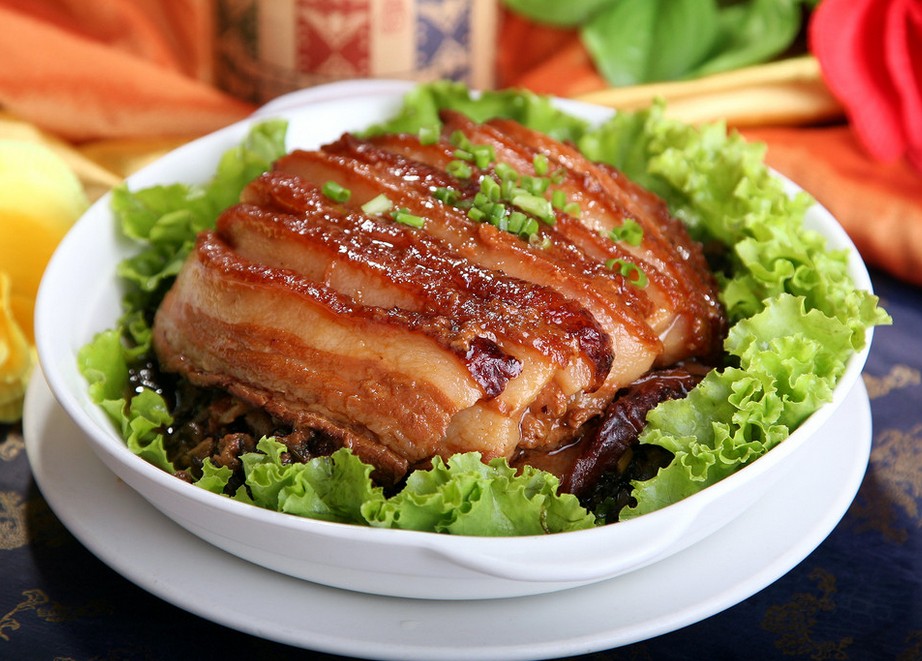1. Yongding dried vegetables
Yongding dried vegetables have a history of over 400 years. They are not only well-known both within and outside the province but also have a considerable influence among overseas Chinese in Southeast Asia. It is made from carefully selected mustard greens through steaming and sun-drying. It has a dark and lustrous color and a rich aroma.
There are two types of Yongding dried vegetables: beet dried vegetables and pickled cabbage dried vegetables. Dried beets are black and shiny in color, and have a sweet and delicious taste. When making it, first wash the fresh mustard greens and sun-dry them for 1-2 days until the leaves become soft. Then, steam them in a steamer, sun-dry them again, and steam them once more. Repeat this process more than three times, which is known as "three steaming and three sun-drying". Some finely processed ones need to be steamed and sun-dried seven times. Dried pickled cabbage is yellowish-brown in color and has a taste that is sour with a hint of sweetness. When making it, first wash the fresh mustard greens, then dry them until soft, chop them up, add salt and rub them into a jar to make them sour. After about a week, take them out, simmer and dry them in the sun. Then steam them in a steamer, dry them in the sun, and steam them again. After steaming and sun-drying more than twice, store them. Yongding dried vegetables are delicious when stir-fried, stewed, steamed or boiled with meat.

2. Beef balls
Select fresh beef arm meat, remove the tendons, membranes and fat, and evenly cut it into one-centimeter-thick layers of meat. Dry it with a dry cloth. Then chop it up and pat it repeatedly to turn the meat color bright red and tender. Add an appropriate amount of salt and potato starch, knead it repeatedly and shape it into meatballs the size of a thumb. Then put it in a basin of cold water and rinse for half an hour. Take it out and put it in a clay pot filled with bone broth. Simmer it over charcoal fire. When the meatballs are fluffy and swollen, add a small amount of pepper, monosodium glutamate, chopped scallions and other seasonings, and they are ready to eat. They are fresh and refreshing, and not greasy when eaten. 
3 Taro buns
Commonly known as "ox swimming bath", it is a must-eat food for people in Yongding during the Chongyang Festival in September. During the Chongyang Festival, it is the harvest season for taro. With a large quantity and high quality, it can be made into taro meatballs, which are soft, delicious and especially tasty. The preparation method is simple: Select good taro seeds, peel off the skin, cook them until done, mash them, let them cool down, then mix in fine and clean potato starch, knead them by hand to form small balls about the size of a child's fist, and shape them into the outer layer for filling. The next step is to make the filling. Finely chop the lean meat, tender bamboo shoots, squid, shiitake mushrooms, etc. and stir-fry them over high heat in a pan. Add an appropriate amount of salt, pepper, monosodium glutamate, etc., and mix with a thin potato starch slurry to simmer until slightly cooked. Finally, wrap the filling into the taro skin and steam it in a steamer over high heat for fifteen to twenty minutes. It's ready to eat.

4. Hakka pickled duck feet and cowhide
Ingredients: 2 pounds of duck feet, 1 bag (400ml) or 2/3 bottle of pickled rice wine, 2/3 bottle of white vinegar, 2 bottles of pickled Sichuan pepper, 20 Sichuan pepper grains, 1 teaspoon of white sugar, an appropriate amount of chicken essence, 1 teaspoon of salt
The Xiayang pickled duck feet are made from top-quality meat duck feet and are treated with a unique pickling secret recipe. The finished duck feet are all of an attractive color and have a rich aroma that makes people's mouths water. The recipe adds some garlic and rice vinegar, which are both seasonings and natural preservatives, ensuring the authentic flavor of the Xiayang pickled duck feet! Take a bite. It's a bit sour, with a hint of sweetness and a touch of spiciness. The unique flavor makes you want to stop eating more and more. This product has a bright color, a crispy texture, and a delicious taste of sourness and spiciness. The product has a golden and inviting color, a pure spicy and fragrant flavor, and a slightly sweet sour taste. The duck meat is extremely fresh, crispy and refreshing. It has a slightly sour and spicy taste, is crispy and refreshing, with a sour and spicy aftertaste. It is a delicious food that is both crispy, fragrant and smooth, and is very suitable for casual gatherings and meals for the general public. Xiayang pickled duck feet have conquered everyone who has tasted them with their unique and excellent flavor. Currently, they have become an indispensable delicacy in some hotels and inns in big cities, serving as a form of entertainment, relaxation, banquets, and residence
Good food that is essential for home travel.

5. Hakka stuffed tofu
Hakka stuffed tofu is a famous Hakka dish. Whenever there is a banquet, this dish is a must. "Niang" is a Hakka verb, meaning "to implant fillings";, and "niang tofu" means "tofu with meat fillings";. Cut the tofu diagonally into triangular pieces about one inch square, fry them in oil for a while, then cut them horizontally and stuff them with semi-cooked seasonings made of pork, glutinous rice, garlic, five-spice powder, chili powder, etc. When eating, sprinkle some pepper powder and scallions on top. The taste is extremely delicious. Stuffed tofu is tender, smooth, fragrant and rich in nutrition. It is a traditional dish for the Hakka people during the Spring Festival.

6. Send 粄
Fa 粄 is a kind of cake that Hakka people often eat during festivals and holidays. It is also called ";cup 粄" or "fa gao".
Method of leavening 粄 : Add some "yeast seed" (baking soda powder) made from distiller's grains to the rice flour slurry. After full fermentation, pour it into a small earthenware bowl and steam until cooked. After steaming, the "fa 粄" rises from the surface of the bowl, resembling a small peak with a pointed top and cracks. The Hakka people call it "xiao", which is a sign of good news coming. So, when sending 粄, one should "laugh as much as possible". The larger the sending, the deeper the crack, symbolizing great wealth and good luck, which is a sign of better fortune. In ancient times, it was popular to eat steamed rice cakes during the Spring Festival for good omens. The pronunciation of "fa gao" in Chinese is similar to that of "getting rich" and "promotion". Because "fa 粄" implies meanings such as getting rich and becoming successful, it is deeply loved by the hakka people.

Stir-fried until 粄 and 粄 are light and sweet, and many people enjoy them as pastries or for breakfast. Just like the rest of the world, Chinese characters also use the word ";sweet" to express feelings of joy and happiness. This is because the first taste that the human tongue can sense is sweetness, and this taste often comes from the same substance - sugar.
The Hakka people have never confined themselves to a dull list of foods. Stir-frying hair 粄 is a further interpretation of happiness and sweetness by the hakka people. By stir-frying all the foods symbolizing beauty, such as orange peels, red dates and sweet winter melon candy, with hair 粄, these imaginative transformations create flavors and nutrients that are breathtaking, and form a part called hakka culture. It can be passed down.

7. Bamboo shoots 粄
Bamboo shoot 粄 is a traditional hakka snack. Bamboo shoots 粄 and beans 粄 their preparation involves two parts: 粄 skin and meat filling. Youdaoplaceholder0 skin is made from potato starch, mixed and kneaded with boiling water, and then combined with an appropriate amount of cooked taro or sweet potato to form thin, small round 粄 blocks. The minced meat mainly consists of half-fat and half-lean pork and bamboo shoots (bamboo shoots from the common bamboo and winter bamboo shoots are preferred), which are chopped separately. It is then served with dried shrimps, shredded squid, mushrooms, pepper powder, salt, etc. Then wrap the meat filling with 粄 skin, pinch it firmly and seal it to form a half-moon shape. Put it in a pot of boiling water and cook until 粄 pieces float up. It's done and can be eaten with seasonings.
8. Grassroots soup
The Hakka people have lived in the mountainous areas all year round and have a special fondness for every plant and tree on the mountains. These plants have medicinal effects on the human body and have been passed down from mouth to mouth. A unique Hakka herbal root dietary culture has gradually taken shape. On the Hakka dining table, a pot of delicious soup made from medicinal roots is indispensable. This has also led to the ability of Hakka people to identify the variety of medicinal roots merely by the aroma and taste of the medicinal root soup.

 Food recommendations-Tourist route-Fujian Tulou Yongding Scenic Area
Food recommendations-Tourist route-Fujian Tulou Yongding Scenic Area